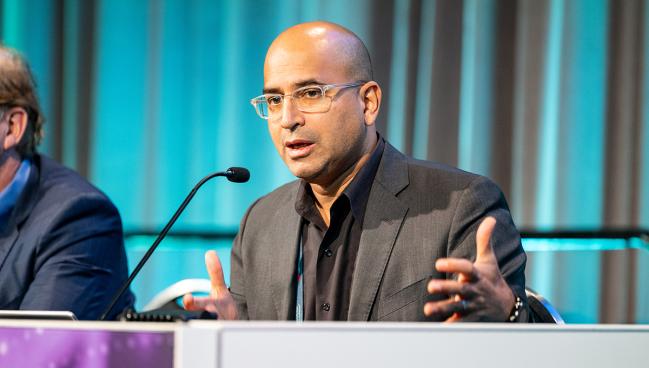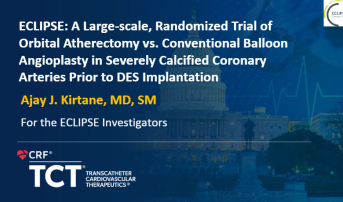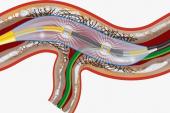ECLIPSE: Orbital Atherectomy No Better Than Balloon Angioplasty in Calcified Lesions
(UPDATED) Specialty technologies are still needed for select patients, but balloons can do the job with “meticulous” planning and imaging.

WASHINGTON, DC—Orbital atherectomy offers no advantages in treating severely calcified lesions over conventional balloon angioplasty before DES implantation, according to new data from the randomized ECLIPSE trial showing that the two options lead to comparable minimal stent area and 1-year target vessel failure.
The trial only included lesions deemed crossable with a balloon by operators, and almost two-thirds of cases were guided by any intravascular imaging.
“If you pick the right lesions and if you also image, then I do believe the trial shows you that you can get good stent expansion and low rates of adverse outcomes with conventional balloons in a lot of patients that have severely calcified lesions,” Ajay J. Kirtane, MD (NewYork-Presbyterian/Columbia University Irving Medical Center, New York, NY), who presented ECLIPSE today in a late-breaking clinical trial session at TCT 2024, told TCTMD. “That’s a pretty important clinical message.”
Interventional cardiologists have many tools at their fingertips to address calcified lesions—which are known to be among the most complex—including angioplasty with conventional balloons as well as cutting and scoring balloons, orbital and rotational atherectomy, and lithotripsy.
These new data indicate that the simplest—and notably the cheapest—approach might be the most reasonable.
Speaking with TCTMD, Mohamed Abdel-Wahab, MD, PhD (Helios Heart Centre, Leipzig, Germany), said the results were not surprising given the “meticulous” lesion preparation coupled with a high rate of intravascular imaging in the study. The ECLIPSE findings “reflect the fact that it's probably not this device or this device or this strategy or that strategy, but if you achieve your goal implanting the stents with a good expansion, then you will get good outcomes.”
After ECLIPSE, Abdel-Wahab said the “liberal use” of orbital atherectomy is “probably not justified,” although it is still a viable option for lesions that can’t be crossed with a balloon. In terms of where to begin, Abdel-Wahab said the evidence now points to starting with a balloon and using intravascular imaging, and then seeing how it goes from there.
“And if you need the additional expensive tools like intravascular lithotripsy, rota, they are there,” he said. “They have to be there, because otherwise you will not be able to complete a certain proportion of your procedures successfully.”
Currently, Abdel-Wahab continued, “we don't have enough evidence to start the procedures with these expensive tools without gaining further knowledge.”
ECLIPSE Results
For the study, Kirtane and colleagues randomized 2,005 patients (mean age 69.9 years; 73% male) with severely calcified lesions as confirmed by core lab analysis to undergo PCI at one of 104 US centers with a lesion preparation strategy of either orbital atherectomy (n = 1,008; Diamondback 360; Abbott) or conventional balloon angioplasty (n = 997) between March 2017 and April 2023. Notably, all patients were considered eligible for balloon angioplasty by angiogram, and any lesions in which the wire couldn’t cross were excluded from the trial.
Intravascular imaging was performed in 62% of both study arms, which was “far in excess of what we would expect in routine clinical practice,” Kirtane said.
Orbital atherectomy procedures used more contrast volume (mean 179.4 vs 160.0 mL) and took longer (mean 73.2 vs 60.1 minutes; P < 0.001 for both) than balloon angioplasty. With angioplasty, scoring and cutting balloons were allowed and used more often than in the atherectomy arm, but intravascular lithotripsy as well as rotational atherectomy was excluded.
The rate of crossover was 2.0% in the orbital atherectomy group and 4.9% in the conventional balloon arm, with just under two-thirds of each of these judged as acceptable after adjudication.
Procedural success was high, at about 86% in each group. Procedural complications were generally low and similar for orbital atherectomy and balloon angioplasty, with the only exception being a higher incidence of slow flow in the former (1.4% vs 0.4%; P = 0.03).
Within the 555-patient subgroup who received OCT, the median minimal stent area (MSA) at the maximum calcium site (primary imaging endpoint) was comparable between the atherectomy and conventional balloon groups (7.44 vs 7.05 mm2; P = 0.08). These measurements were substantially higher than what the researchers had predicted they would find: 5.5 mm2 with orbital atherectomy and 4.5 mm2 with balloons.
Among the entire cohort, there was no difference in the primary clinical endpoint of target vessel failure at 1 year (11.5% vs 10.0%; P = 0.28). Other 1-year clinical outcomes were low and similar between the groups.
At 30-days, there were eight cardiac deaths in the orbital atherectomy arm, but only two were determined by the clinical events committee to be related to the device and another two possibly related.
A subanalysis by enrollment cohort also showed no difference in TVF between orbital atherectomy and balloon angioplasty whether patients received OCT (HR 1.18; 95% CI 0.63-2.21) or not (HR 1.15; 95% CI 0.85-1.56; P for interaction = 0.95). However, those who did receive OCT reported significantly less TVF than those without OCT (7.2% vs 12.2%; adjusted HR 0.68; 95% CI 0.55-0.84).
Kirtane said he was surprised by the results given that in clinical practice “there are a lot of severely calcified lesions that are inappropriately treated. We see people coming back with underexpanded stents, and we know that's due to inadequate lesion preparation. Lesion preparation is something that all of us emphasize, but yet in clinical practice doesn't get done.”
‘A Lot of Tools in Our Toolbox’
The ECLIPSE data support future use of orbital atherectomy only as “a niche technology for areas that you cannot do with angioplasty,” Sanjit Jolly, MD (McMaster University, Hamilton, Canada), told TCTMD. “For example, maybe calcified nodules where you try with balloon angioplasty and you cannot expand those balloons.”
Speaking in a press conference, Wayne Batchelor, MD (Inova Heart and Vascular Institute, Fairfax, VA), noted that interventional cardiologists “have a lot of tools in our toolbox.”
“We’ve got to understand how to use those tools most effectively for the patient, but also most effectively in terms of resource utilization,” he added.
The balloons used in balloon angioplasty have improved with time, and the rate of intravascular imaging has risen and notably improved outcomes, Batchelor noted. “So, I think this is comforting to interventional cardiologists because you can get away with ballooning a lot of lesions where we thought you might not be.”
How lithotripsy might compare is “missing” from this analysis, and future trials will help inform this space, said Batchelor.
Kenneth Rosenfield, MD (Massachusetts General Hospital, Boston), added that the study findings were not likely to change his practice because “many of us have now converted more to intravascular lithotripsy.”
That said, the most challenging calcified lesions will still need to be treated with something beyond conventional balloon angioplasty, Rosenfield specified. “I just hope this does not kill orbital atherectomy or rotational atherectomy because there's definitely a role for it in some cases.”
Kirtane agreed. “There are so many people in the US and in the world who don’t know how to use atherectomy,” he said. “You need to know how to use atherectomy to do all the cases.”
During the session, panelist Gary Mintz, MD (Cardiovascular Research Foundation, New York, NY), suggested that a secondary analysis looking at calcium severity will be “critical” because sometimes calcium that comes across as severe on angiography can be successfully treated by a conventional balloon strategy, he said. “So I think that secondary analysis will also help tease out why there were such good results, especially in the balloon arm.”
Cost is also “not a minor issue” when comparing all of the different options for treating these lesions, said Abdel-Wahab.
Kirtane estimated conventional balloons cost around $100, specialty balloons $1,000, atherectomy $1,500, and lithotripsy $4,500 per case. “There's a lot of different options price-wise and then there's also the reimbursement angle, too,” he said. With the ECLIPSE data, “I do feel that [conventional balloon angioplasty] is a first-line approach at present and probably a highly cost-effective approach.”
Call for More Trials
The study shows the importance of doing more clinical trials comparing all of the available options for treating calcified lesions, many argued.
“In this space, we have devices that have been approved on the basis of single-arm studies and no comparative data that's out there other than this,” Kirtane said. “This is really important because as clinicians we make treatment decisions based on these.”
Abdel-Wahab agreed on the need for other randomized trials. “There are a lot of algorithms published, suggestions, and consensus papers that suggest we need to use this when we have that, we need to use this when we have that,” he pointed out. “But actually this is all based on feelings or very limited evidence rather than randomized evidence.”
Trials of lithotripsy specifically are warranted based on its growing use, Jolly said. New trials should also compare various strategies and not simply devices, he argued. “Perhaps we need a strategy trial of a very simple approach versus using an array of different technologies.”
During the session, panelist J. Dawn Abbott, MD (Brown University, Providence, RI), said ECLIPSE helps somewhat in this regard, having shown that the strategy of upfront atherectomy “doesn’t seem to be effective.” Going forward, “we need to study each device within each strategy,” she added.
The Case for Intravascular Imaging
Though the study was not designed to show an advantage with intravascular imaging, it inevitably highlighted its benefits.
Indeed, Mintz observed, ECLIPSE “almost” comes across like an imaging study “rather than a calcium modification study,” given its impact on the results.
“Where imaging should be used is precisely in this area,” Jolly said. “And imaging may help you decide what therapy to use. You predilate with a balloon, you image, you see fractures in the calcium on imaging, and you just go ahead and don't use any adjunctive technology. So, it can be very helpful in helping you decide what to do.”
Anna Sonia Petronio, MD (University Hospital, Pisa, Italy), agreed. “It is something that we have learned in the last years,” she said during the press conference. “Imaging is essential.”
A lot of operators are using intravascular imaging more often now, as shown in ECLIPSE, added Kirtane. “Clearly it's a good thing, but I think that that message does have to get out into routine clinical practice,” he said.
Yael L. Maxwell is Senior Medical Journalist for TCTMD and Section Editor of TCTMD's Fellows Forum. She served as the inaugural…
Read Full BioSources
Kirtane AJ. ECLIPSE: a large-scale, randomized trial of orbital atherectomy vs. conventional balloon angioplasty in severely calcified coronary arteries prior to DES implantation. Presented at: TCT 2024. October 29, 2024. Washington, DC.
Disclosures
- The study was funded by Abbott.
- Kirtane reports institutional funding to Columbia University and/or Cardiovascular Research Foundation from Medtronic, Boston Scientific, Abbott Vascular, Amgen, CathWorks, Concept Medical, Philips, ReCor Medical, Neurotronic, Biotronik, Chiesi, Bolt Medical, Magenta Medical, SoniVie, and Shockwave Medical. In addition to research grants, institutional funding includes fees paid to Columbia University and/or Cardiovascular Research Foundation for consulting and/or speaking engagements in which Kirtane controlled the content. Personal: Equity options in Bolt Medical, Airiver; Travel Expenses/Meals from Amgen, Medtronic, Biotronik, Boston Scientific, Abbott Vascular, CathWorks, Concept Medical, Novartis, Philips, Abiomed, ReCor Medical, Chiesi, Zoll, Shockwave, and Regeneron.
- Abdel-Wahab reports receiving consultant fee/honoraria/speaker’s bureau from Medtronic, Boston Scientific, and Shockwave Medical.





Comments